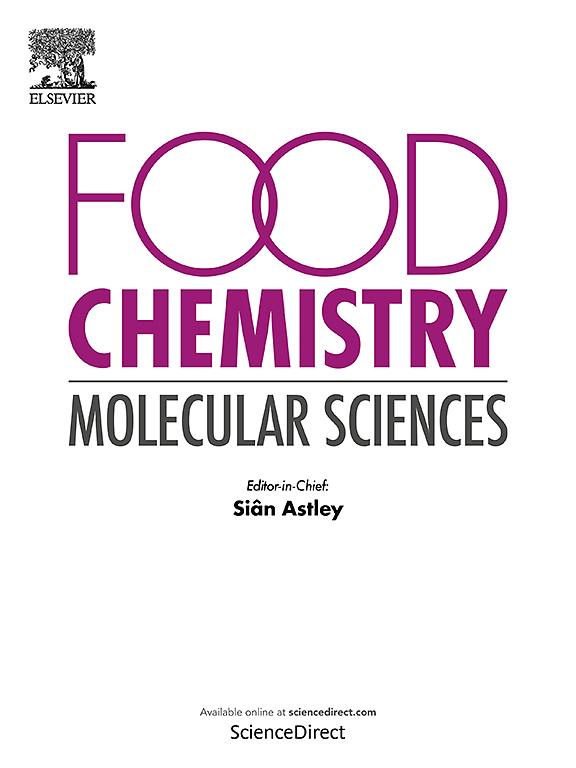橄榄厂废水酚提取物维持线粒体生物能量氧化损伤。
IF 4.1
Q2 FOOD SCIENCE & TECHNOLOGY
引用次数: 0
摘要
在过去的几年里,由于橄榄油副产品具有潜在的高生物价值,许多人致力于橄榄油副产品的回收和增值。橄榄厂废水(OMWW)是一种深绿色的液体,主要由橄榄果实植被水组成,由于其含有大量具有强抗氧化性能的酚类化合物,因此在这方面得到了特别的利用。在我们之前的工作中,我们生产了不同的富含羟基酪醇-和羟基酪醇/橄榄苦苷的OMWW组分(分别为C和OPE提取物),它们在体外表现出相当大的抗微生物和自由基清除活性。基于这些发现,本研究旨在评估C和OPE样品对小鼠成纤维细胞样细胞(NCTC)线粒体功能和氧化应激反应的影响。因此,OMWW酚提取物被证明可以促进线粒体的生物发生,降低细胞对过氧化氢的敏感性。此外,高分辨率呼吸测定实验首次揭示了通过选择性树脂提取回收的OMWW酚类物质在防止氧化损伤后线粒体呼吸衰竭方面的有效性。收集到的数据明确地证明了我们的富酚组分的生物活性,支持了再利用橄榄厂废水的优势,以低成本,高附加值的分子,可以用于改善健康和营养产品。本文章由计算机程序翻译,如有差异,请以英文原文为准。
Phenolic extract from olive mill wastewater sustains mitochondrial bioenergetics upon oxidative insult
In the last few years, many efforts have been devoted to the recovery and valorization of olive oil by-products because of their potentially high biological value. The olive mill wastewater (OMWW), a dark-green brown colored liquid that mainly consists of olive fruit vegetation water, is particularly exploited in this regard for its great content in phenolic compounds with strong antioxidant properties. In our previous work, we produced different OMWW fractions enriched in hydroxytyrosol- and hydroxytyrosol/oleuropein (i.e. C and OPE extracts, respectively) that exhibited considerable anti-microbial and radical-scavenging activities in vitro. Based on these findings, the present study aimed to assess the impact of C and OPE samples on mitochondrial function and oxidative stress response in mouse fibroblast-like cells (NCTC). Accordingly, OMWW phenolic extracts proved to enhance mitochondrial biogenesis and to reduce cellular sensitivity to hydrogen peroxide. Moreover, high-resolution respirometry experiments first time revealed the efficiency of OMWW phenols recovered by selective resin extraction in preventing mitochondrial respiration failure upon oxidative insult. Collected data definitely demonstrate the bioactivity of our phenolic-rich fractions, supporting the advantages of reusing the olive mill wastewater to generate, at low-cost, high added value molecules that could be useful for the improvement of health and nutrition products.
求助全文
通过发布文献求助,成功后即可免费获取论文全文。
去求助
来源期刊

Food Chemistry Molecular Sciences
Agricultural and Biological Sciences-Food Science
CiteScore
6.00
自引率
0.00%
发文量
83
审稿时长
82 days
期刊介绍:
Food Chemistry: Molecular Sciences is one of three companion journals to the highly respected Food Chemistry.
Food Chemistry: Molecular Sciences is an open access journal publishing research advancing the theory and practice of molecular sciences of foods.
The types of articles considered are original research articles, analytical methods, comprehensive reviews and commentaries.
Topics include:
Molecular sciences relating to major and minor components of food (nutrients and bioactives) and their physiological, sensory, flavour, and microbiological aspects; data must be sufficient to demonstrate relevance to foods and as consumed by humans
Changes in molecular composition or structure in foods occurring or induced during growth, distribution and processing (industrial or domestic) or as a result of human metabolism
Quality, safety, authenticity and traceability of foods and packaging materials
Valorisation of food waste arising from processing and exploitation of by-products
Molecular sciences of additives, contaminants including agro-chemicals, together with their metabolism, food fate and benefit: risk to human health
Novel analytical and computational (bioinformatics) methods related to foods as consumed, nutrients and bioactives, sensory, metabolic fate, and origins of foods. Articles must be concerned with new or novel methods or novel uses and must be applied to real-world samples to demonstrate robustness. Those dealing with significant improvements to existing methods or foods and commodities from different regions, and re-use of existing data will be considered, provided authors can establish sufficient originality.
 求助内容:
求助内容: 应助结果提醒方式:
应助结果提醒方式:


